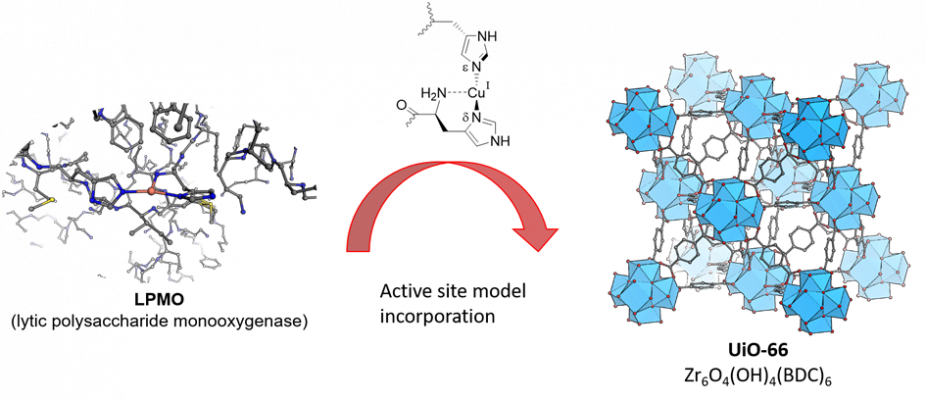Metal-organic frameworks (MOFs) are crystalline solids consisting of, as the name implies, both metallic and organic building blocks. By connecting metal ions, or clusters of metal ions, together with organic molecules (often referred to as “linkers”), a framework in 2 or 3 dimensions can be constructed.

Due to the crystalline nature of these materials, it is common for MOFs to be highly porous. Having a high surface area, coupled with the fact that many MOFs are exceptionally stable towards thermal, physical and chemical treatment makes MOFs interesting materials for many areas of applications: e.g. catalysis, gas separation/purification, sensors, and drug-delivery systems. Especially zirconium-based MOFs have exhibited unprecedented stability, with UiO-66 being a prime example. Additionally, MOFs can be chemically tailored for specific needs. Through functionalization, MOFs are prime candidates as scaffold for intricate catalytic centers for many reactions of interest, such as the highly sought-after methane to methanol partial oxidation reaction.

The modular construction of metal organic frameworks allows adding functionality to both, linker and cluster. In CuBE, we aim to accommodate bioinspired copper coordination compounds in the metal organic framework. Based on the enzymologists’ findings for LPMO and pMMO enzymes, we design and synthesize copper catalysts for C-H activation.
For more information check these articles:
Cavka, J. H.; Jakobsen, S.; Olsbye, U.; Guillou, N.; Lamberti, C.; Bordiga, S.; Lillerud, K. P..; A New Zirconium Inorganic Building Brick Forming Metal Organic Frameworks with Exceptional Stability. J. Am. Chem. Soc. 2008, 130 (42), 13850–13851.
Jiang, J.; Gándara, F.; Zhang, Y.-B.; Na, K.; Yaghi, O. M.; Klemperer, W. G. Superacidity in Sulfated Metal–Organic Framework-808. J. Am. Chem. Soc. 2014, 136 (37), 12844–12847.
Bai, Y.; Dou, Y.; Xie, L.-H.; Rutledge, W.; Li, J.-R.; Zhou, H.-C. Zr-Based Metal–Organic Frameworks: Design, Synthesis, Structure, and Applications. Chem. Soc. Rev. 2016, 45 (8), 2327–2367.
Liu, Y.; Klet, R. C.; Hupp, J. T.; Farha, O. Probing the Correlations between the Defects in Metal–Organic Frameworks and Their Catalytic Activity by an Epoxide Ring-Opening Reaction. Chem. Commun. 2016, 52 (50), 7806–7809.
Baek, J.; Rungtaweevoranit, B.; Pei, X.; Park, M.; Fakra, S. C.; Liu, Y.-S.; Matheu, R.; Alshmimri, S. A.; Alshehri, S.; Trickett, C. A.; Somorjai, G. A.; Yaghi, O. M. Bioinspired Metal–Organic Framework Catalysts for Selective Methane Oxidation to Methanol. J. Am. Chem. Soc. 2018, 140 (51), 18208–18216.
Yang, D.; Gates, B. C. Catalysis by Metal Organic Frameworks: Perspective and Suggestions for Future Research. ACS Catal. 2019, 9 (3), 1779–1798.